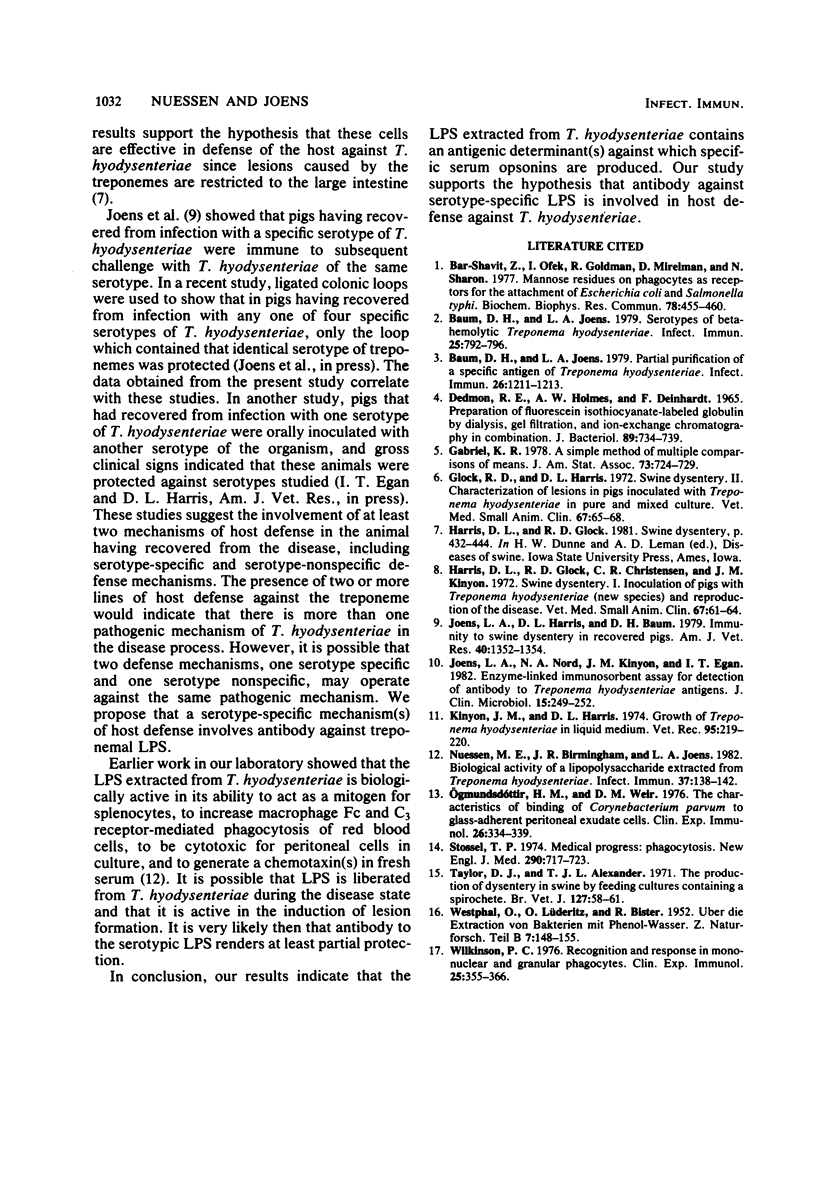Abstract
Treponema hyodysenteriae was shown to attach to mouse peritoneal cells in the absence of serum opsonins in vitro. If serotype-specific antiserum from pigs was added to the media and treponemes of that corresponding serotype were employed in the assay, the amount of attachment increased an average of 3.7 times that of the control without pig sera. However, the amount of attachment was increased an average of only 1.5 times that of the control if organisms of any noncorresponding serotype of T. hyodysenteriae were used in the assay. Since the lipopolysaccharide (LPS) extracted from T. hyodysenteriae is the basis for serotyping the treponeme, the ability of these distinct LPS types to block attachment by blocking opsonization of the organisms was tested. Attachment, using corresponding antisera and treponemes, was blocked by LPS extracted from treponemes of that serotype, but not by LPS extracted from treponemes of other serotypes. These results indicate that antibody response to T. hyodysenteriae infection in pigs is serotype-specific. Furthermore, since opsonization and subsequent attachment of bacteria to phagocytes is known to be a protective mechanism, we suggest that the LPS may be an important antigen in the stimulation of host defense against the treponeme.
Full text
PDF



Selected References
These references are in PubMed. This may not be the complete list of references from this article.
- Bar-Shavit Z., Ofek I., Goldman R., Mirelman D., Sharon N. Mannose residues on phagocytes as receptors for the attachment of Escherichia coli and Salmonella typhi. Biochem Biophys Res Commun. 1977 Sep 9;78(1):455–460. doi: 10.1016/0006-291x(77)91276-1. [DOI] [PubMed] [Google Scholar]
- Baum D. H., Joens L. A. Partial purification of a specific antigen of Treponema hyodysenteriae. Infect Immun. 1979 Dec;26(3):1211–1213. doi: 10.1128/iai.26.3.1211-1213.1979. [DOI] [PMC free article] [PubMed] [Google Scholar]
- Baum D. H., Joens L. A. Serotypes of beta-hemolytic Treponema hyodysenteriae. Infect Immun. 1979 Sep;25(3):792–796. doi: 10.1128/iai.25.3.792-796.1979. [DOI] [PMC free article] [PubMed] [Google Scholar]
- DEDMON R. E., HOLMES A. W., DEINHARDT F. PREPARATION OF FLUORESCEIN ISOTHIOCYANATE-LABELED GAMMA-GLOBULIN BY DIALYSIS, GEL FILTRATION, AND IONEXCHANGE CHROMATOGRAPHY IN COMBINATION. J Bacteriol. 1965 Mar;89:734–739. doi: 10.1128/jb.89.3.734-739.1965. [DOI] [PMC free article] [PubMed] [Google Scholar]
- Glock R. D., Harris D. L. Swine dysentery. II. Characterization of lesions in pigs inoculated with Treponema hyodysenteriae in pure and mixed culture. Vet Med Small Anim Clin. 1972 Jan;67(1):65–68. [PubMed] [Google Scholar]
- Harris D. L., Glock R. D., Christensen C. R., Kinyon J. M. Inoculation of pigs with Treponema hyodysenteriae (new species) and reproduction f the disease. Vet Med Small Anim Clin. 1972 Jan;67(1):61–64. [PubMed] [Google Scholar]
- Joens L. A., Harris D. L., Baum D. H. Immunity to Swine dysentery in recovered pigs. Am J Vet Res. 1979 Oct;40(10):1352–1354. [PubMed] [Google Scholar]
- Joens L. A., Nord N. A., Kinyon J. M., Egan I. T. Enzyme-linked immunosorbent assay for detection of antibody to Treponema hyodysenteriae antigens. J Clin Microbiol. 1982 Feb;15(2):249–252. doi: 10.1128/jcm.15.2.249-252.1982. [DOI] [PMC free article] [PubMed] [Google Scholar]
- Kinyon J. M., Harris D. L. Growth in Treponema hyodysenteriae in liquid medium. Vet Rec. 1974 Sep 7;95(10):219–220. doi: 10.1136/vr.95.10.219. [DOI] [PubMed] [Google Scholar]
- Nuessen M. E., Birmingham J. R., Joens L. A. Biological activity of a lipopolysaccharide extracted from Treponema hyodysenteriae. Infect Immun. 1982 Jul;37(1):138–142. doi: 10.1128/iai.37.1.138-142.1982. [DOI] [PMC free article] [PubMed] [Google Scholar]
- Ogmundsdóttir H. M., Weir D. M. The characteristics of binding of Corynebacterium parvum to glass-adherent mouse peritoneal exudate cells. Clin Exp Immunol. 1976 Nov;26(2):334–339. [PMC free article] [PubMed] [Google Scholar]
- Stossel T. P. Phagocytosis (first of three parts). N Engl J Med. 1974 Mar 28;290(13):717–723. doi: 10.1056/NEJM197403282901306. [DOI] [PubMed] [Google Scholar]
- Taylor D. J., Alexander T. J. The production of dysentery in swine by feeding cultures containing a spirochaete. Br Vet J. 1971 Nov;127(11):58–61. doi: 10.1016/s0007-1935(17)37282-2. [DOI] [PubMed] [Google Scholar]
- Wilkinson P. C. Recognition and response in mononuclear and granular phagocytes. Clin Exp Immunol. 1976 Sep;25(3):355–366. [PMC free article] [PubMed] [Google Scholar]


